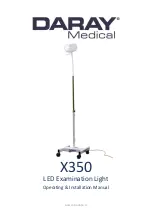
16
MAC 101 user manual
Operation and effects
Warning! Read “Safety Information” starting on page 3 before installing, powering, operating or
servicing the MAC 101.
This section describes only DMX control features that require particular explanation. See “DMX protocols”
on page 22 for a full list of the DMX channels and values required to control the different effects.
Pan and tilt
The MAC 101’s moving head can be panned through 540° and tilted through 240°. The speed of pan/tilt
movement can be adjusted via the control panel.
All DMX modes offer fine control of pan and tilt. In each case, the main control channel sets the first 8 bits
(the most significant byte or MSB), and the fine channel sets the second 8 bits (the least significant byte or
LSB) of the 16-bit control byte. In other words, the fine channel works within the position set by the main
channel.
Shutter effect
The electronic ‘shutter’ effect provides instant open and blackout, variable speed regular and random strobe
and opening/closing pulse effects as well as burst and sinewave effects.
Dimming
Overall intensity can be adjusted 0 - 100% using electronic dimming. See “Dimming” on page 14.
Controlling color (standard MAC 101 RGB only)
Color wheel effect
The electronic ‘color wheel’ effect gives the convenience and feel of a mechanical color wheel and lets you
snap between 33 different full LEE-referenced colors. You can also scroll continuously forwards or
backwards through the colors or display random colors at variable speed.
The color wheel effect is available in all DMX modes.
The approximate RGB equivalents of the ‘color wheel’ colors are given in “LEE colors and RGB equivalents”
on page 26.
Color wheel priority
Even if the fixture is set to
RAW
or
RGB
mode, the color wheel effect channel still has priority over the RGB
channels. To use the RGB channels, you must set the color wheel effect channel to a DMX value from 000 -
009. If you move the color wheel channel to a DMX value above 009 at any point, the color wheel effect
takes over and overrides RGB control.
RGB color mixing
RGB color mixing is available in raw or calibrated modes:
• Raw RGB mode (
RAW
) is uncalibrated and allows all LEDs to be operated to their absolute maximum
output regardless of color calibration issues.
• Calibrated RGB mode (
RGB
) gives slightly reduced LED power but sets LEDs to their factory calibration
output power to give the best-matched color and white output across multiple fixtures.
CTC (Color Temperature Control)
If the fixture is set to
RAW
or
RGB
mode, setting the CTC channel (12) to a DMX value greater than 019 will
adjust the fixture’s overall color temperature, i.e. the color that has been set using the color wheel channel
or the RGB channels. Note that the more saturated the color, the less it will be affected by adjustments in
color temperature. The biggest CTC variation is available when displaying white.
Overall color temperature can be varied from 10 000 - 2500 K. The default color temperature is 5 600 K.
















































